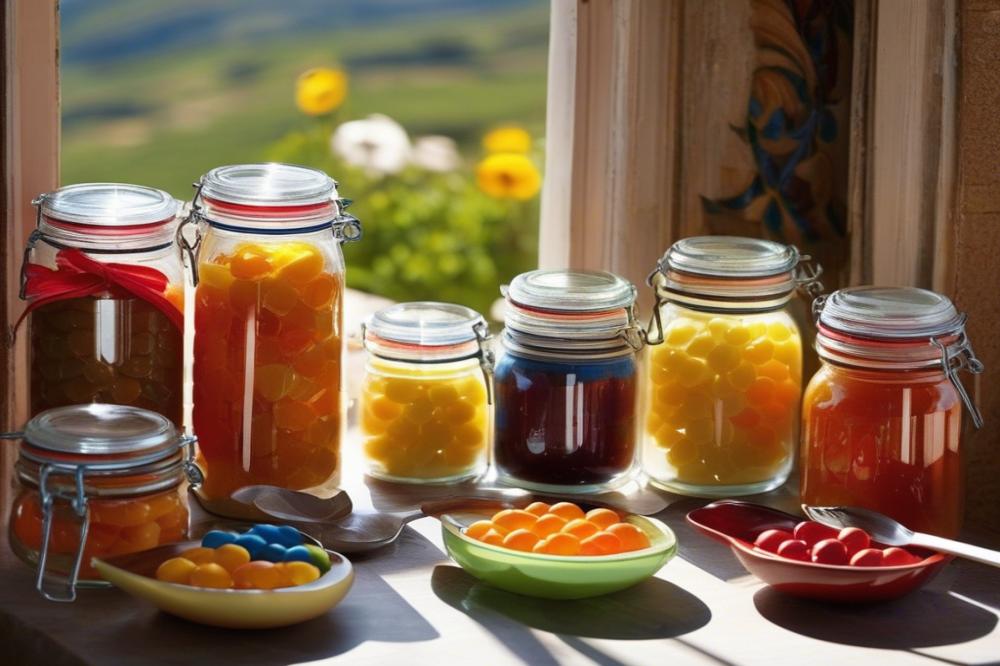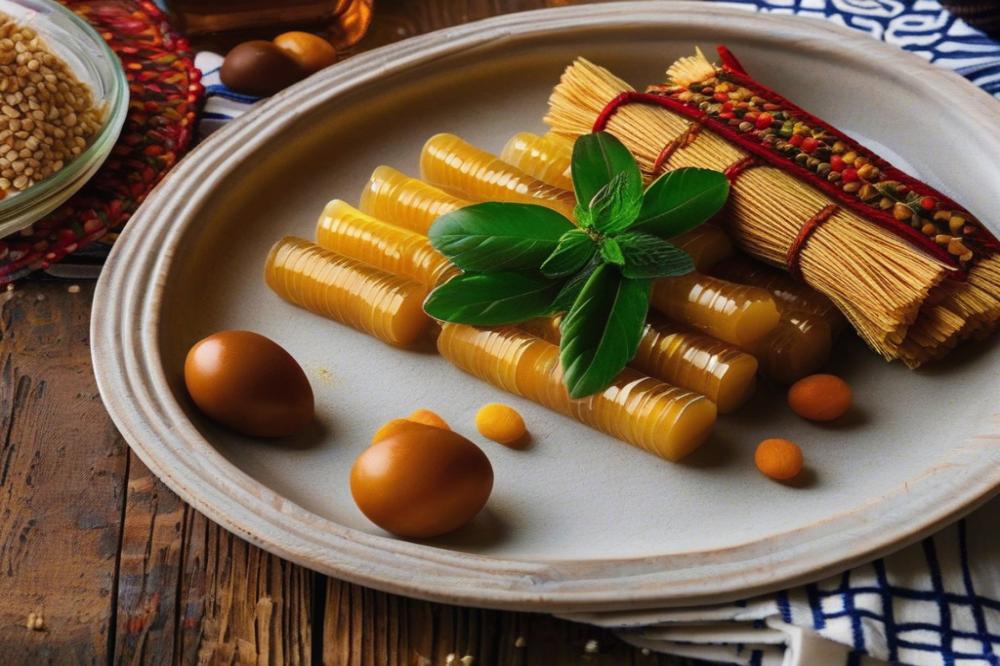recipebix.com/the-perfect-recipe-for-loukoumades-greek-honey-puffs”>Glyko Koutaliou and the Art of Greek Spoon Sweets
In the heart of Greek culture, Glyko Koutaliou holds a special place. This delightful dessert is more than just a sweet treat; it symbolizes warmth, hospitality, and tradition. Offered to guests with open arms, these spoon sweets create a sense of belonging and comfort. They reflect the rich history and culinary practices that have evolved over generations.
Greek Spoon Sweets are a traditional dessert, often made from seasonal fruits. These sweets are not just simple confections. They tell a story of creativity and resourcefulness. When fresh fruits are in abundance, they can be transformed into vibrant fruit preserves, capturing the essence of summer in a jar. Families take pride in making these treats at home, passing down treasured recipes from one generation to the next.
The process of creating homemade versions of Greek spoon sweets is a labor of love. It involves carefully selecting the ripest fruits, cooking them gently in sugar syrup, and watching them transform into something truly delightful. The importance of preserving fruits through this method cannot be overstated. It allows families to enjoy the flavors of their harvest year-round. Every spoonful evokes memories and brings people together. With at least one recipe for this cultural dessert, anyone can experience the joy of making and sharing these unique sweets.
Glyko Koutaliou: A Traditional Greek Spoon Sweet

Glyko Koutaliou refers to a delightful category of Greek desserts known as spoon sweets. These treats are not just simple desserts; they are often served as a gesture of hospitality. When a guest visits a Greek home, it is customary to offer a small spoonful of this fruit preserve along with a glass of cold water. The appreciation for such sweets runs deep in the heart of Greece.
Historically, these sweets have their roots in ancient Greece. They were originally created as a way to preserve fruits for longer periods. Families would often gather to prepare large batches using seasonal fruits. The making of these sweets became a cherished tradition passed down through generations. It reflects the importance of sharing and hospitality in Greek culture. Each sweet represents love, warmth, and an invitation to share a moment with others.
Various types of fruits are typically used for these preserves. Common examples include apricots, cherries, and grapes. The fruit is often combined with sugar syrup, allowing the flavors to meld beautifully. Some families may even use oranges and figs, each contributing its own unique taste. Homemade versions allow for creativity, enabling variations based on personal or family preference.
This dessert is not just a sweet treat but an experience. Eating Glyko Koutaliou opens a window to Greek traditions and the vibrant culture surrounding food. These spoon sweets stand as a symbol of the care and effort involved in preserving fruits, transforming them into something extraordinary.
Ingredients and Cooking Instructions

List of Ingredients with Measurements
- 2 cups of fresh cherries, figs, or oranges (choose your favorite fruit)
- 4 cups of granulated sugar
- 2 cups of water
- Juice of 1 lemon (optional for a tangy flavor)
- 1 stick of cinnamon (optional for a warm spice)
Step-by-Step Cooking Method
Begin by preparing the fruit for preservation. For cherries, remove the pits and leave the skins intact. If you choose figs, cut them into quarters. Oranges should be peeled, and the segments can be left whole or sliced, depending on your preference. The goal is to ready the fruit for the sugar syrup.
Next, it’s time to cook the sugar syrup. In a large saucepan, combine the sugar and water. Heat the mixture over medium heat, stirring until the sugar dissolves completely. Once it reaches a gentle boil, you can add the lemon juice and cinnamon stick if you’re using them. Allow this syrup to simmer for about 10 minutes. This concentration creates a perfect environment for the fruits to soften and absorb the flavors.
Combining the fruit with the syrup comes next. Carefully add the prepared fruit to the hot syrup. Stir gently so that the fruit doesn’t break apart. Let it simmer for an additional 20-30 minutes. The fruit should become translucent and tender, while the syrup thickens into a luscious coating.
Lastly, bottling and storing the sweet is crucial for preservation. Use sterilized glass jars to remove any impurities. Pour the hot fruit and syrup mixture into the jars, making sure the fruit is submerged in the syrup. Seal the jars tightly and let them cool at room temperature. Once cooled, store in a cool, dry place. This homemade dessert provides a delightful taste of traditional Greek cuisine.
Nutritional Information

Understanding the nutritional content of traditional Greek desserts is essential for making informed choices. A typical recipe for Glyko Koutaliou involves a variety of ingredients, each contributing differently to the overall nutritional value. Fruits used in this dessert, such as figs, cherries, or walnuts, vary widely in their nutrient profiles.
Sugar plays a significant role in this sweet treat. The homemade sugar syrup used in the recipe adds calories but also acts as a preservative, giving the fruit preserve a longer shelf life. A standard serving can provide approximately 100 to 200 calories, depending on the amount of syrup used and the type of fruit.
Breakdown of Nutritional Values
For example, a serving of cherry spoon sweet includes natural sugars from the fruit along with vitamin C and fiber. On the other hand, fig preserves offer calcium, iron, and other vital minerals. The nuts, if added, provide healthy fats, protein, and antioxidants, enriching the dessert further.
Health Aspects of Traditional Greek Desserts
Desserts in Greek cuisine often highlight the use of natural ingredients. Fruits are part of a healthy diet when eaten in moderation. Each serving of a cultural dessert may provide beneficial nutrients while indulging one’s sweet tooth. Utilizing fresh, seasonal fruits enhances the health benefits of these sweets.
Fruits are generally low in calories and high in vitamins, making them a great choice for desserts. Homemade versions of these sweets allow for control over ingredients, reducing excessive sugars while maintaining flavor. Traditional recipes often include less sugar than modern variations, helping to maintain a better balance.
Recommendations for Moderate Consumption
Enjoying these sweets occasionally is a key aspect of a balanced diet. Moderation is crucial since sugary desserts can lead to health issues if overindulged. Pairing the fruit preserves with yogurt can turn it into a nutritious snack, combining the sweetness of the dessert with the benefits of dairy.
Serving sizes should be considered carefully. A small spoonful is often enough to satisfy cravings. Balancing these treats with other healthful foods throughout the day can help maintain overall wellness. It’s all about enjoying the flavors while being aware of the nutritional content.
Tips for Perfecting Glyko Koutaliou

Best Practices for Selecting Ripe Fruits
Choosing the right fruits is fundamental for a successful dessert. Look for fruits that are in-season for the best flavor. For instance, peaches should be slightly soft to the touch, signaling their ripeness. Similarly, cherries should have a deep, rich color. Always avoid fruits with blemishes or bruises. Clean, fresh options will yield the most delicious fruit preserve. When selecting citrus, pick firm specimens with bright skin. The right choice of fruit can elevate your homemade recipe, making it truly special.
Cooking Tips for Achieving the Perfect Syrup Consistency
Creating the ideal sugar syrup requires attention and practice. Begin by mixing sugar and water in equal parts. Use a heavy-bottomed pot for even heating. Heat the mixture slowly to avoid burning. Stir occasionally until the sugar dissolves completely. After boiling, keep an eye on the syrup’s texture. The goal is a thick, glossy appearance that coats the back of a spoon. Test it by letting a drop fall; it should create a small ribbon. If unsure, use a thermometer. The syrup should reach about 220°F to achieve the perfect consistency.
Storage Tips to Maintain Freshness and Flavor
After the sweets are prepared, proper storage is key. Choose clean, dry glass jars for preserving fruits. Filling them while the syrup is still hot will help create a vacuum seal. Tighten the lids only once they have cooled to room temperature. Store jars in a cool, dark place away from sunlight. A pantry is an ideal location. Homemade sweets can last for several months when stored correctly. Once opened, refrigerate any leftovers and use them within a few weeks for the best flavor. Enjoy the taste of this cultural dessert with every spoonful!
Serving and Pairing Suggestions
Traditional Ways to Serve Glyko Koutaliou
Glyko Koutaliou offers a delightful addition to any meal. The most common way to present this traditional sweet is on a small plate. A spoon adorned with the fruit preserves is placed beside it. Guests can savor the treat in a way that highlights the beauty of Greek cuisine. Often, it is served during special occasions, symbolizing hospitality and warmth. Presentation is key; a simple garnish, such as a mint leaf, can elevate the dish.
Pairing with Coffee or Yogurt
Serving these sweets with a strong cup of Greek coffee creates a balanced experience. The rich flavor of the coffee complements the sweetness of the dessert perfectly. Alternatively, pairing with thick yogurt introduces a creamy texture that enhances the overall taste. This combination works especially well for breakfast or a light snack. The tartness of the yogurt contrasts beautifully with the sweetness found in the sugar syrup.
Incorporating into Other Dishes or Desserts
Using the sweets in various recipes can impress your family and friends. For example, one can chop the fruit preserves and blend them into a cake batter. This adds an unexpected twist to any dessert while providing moisture and flavor. Additionally, consider drizzling the syrup over pancakes or waffles. Such adaptations take advantage of the homemade quality of these treats. They can also inspire creativity in your baking endeavors.
Final Thoughts
Glyko Koutaliou holds a cherished spot in the heart of Greek cuisine. These delightful spoon sweets represent more than just a dessert; they embody tradition and hospitality. Family gatherings, religious celebrations, and special occasions often feature these treats. Each serving offers a taste of history, connecting generations through flavors that have been passed down.
Making this recipe at home can be an enjoyable experience. Engaging in the process allows for creativity while also sharpening culinary skills. Gathering friends or family can turn the task into a fun activity, as everyone can take part in the preparation. The satisfaction of preparing a beloved dish should not be underestimated. Once you taste your homemade creation, it is likely to become a new favorite.
Moreover, exploring other traditional Greek recipes can deepen your appreciation for this rich culinary culture. There are numerous techniques to learn, each with its own story. Preserving methods, for example, reveal fascinating insights into how flavors are maintained over time. Families often have their own variations, adding a personal touch to every dish. With each recipe, a new adventure awaits in the kitchen.



